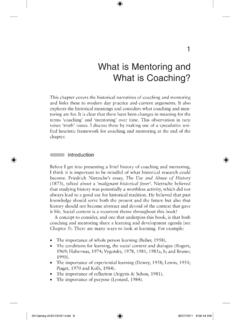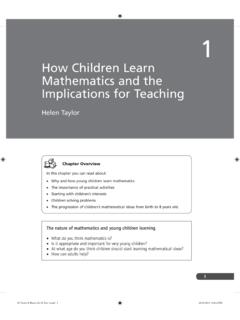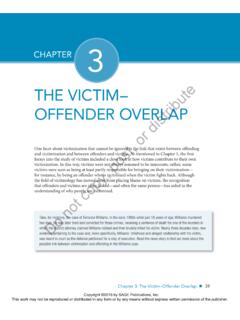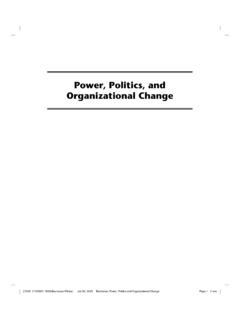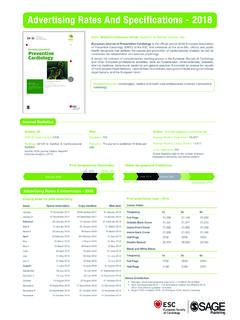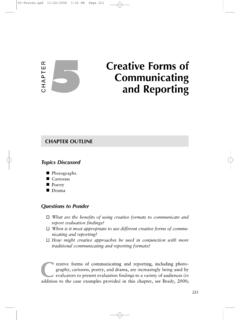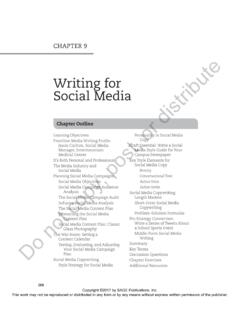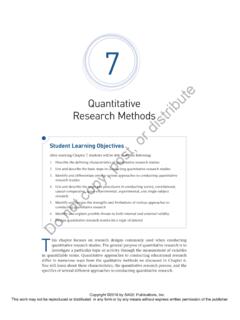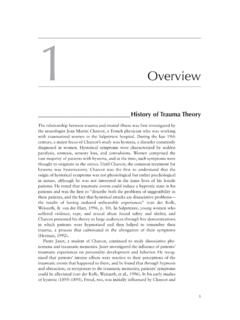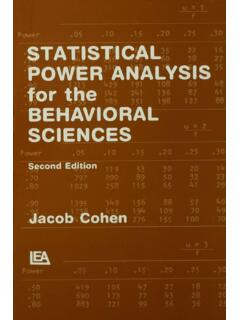Transcription of Multiple Regression Analysis - SAGE Publications Inc
1 157 CHAPTER 5 AMultiple Regression General ConsiderationsMultiple Regression Analysis , a term first used by Karl Pearson (1908), is an extremely useful extension of simple linear Regression in that we use several quantitative (metric) or dichotomous variables in combination rather than just one such variable to predict or explain the value of a quantitatively mea-sured criterion (outcome/dependent) variable. Most researchers believe that using more than one predictor or potentially explanatory variable can paint a more complete picture of how the world works than is permitted by simple linear Regression because behavioral scientists generally believe that behav-ior, attitudes, feelings, and so forth are determined by Multiple variables rather than just one.
2 Using only a single variable as a predictor or explanatory variable as is done in simple linear Regression will at best capture only one of those sources. In the words of one author (Thompson, 1991), multivariate methods such as Multiple Regression Analysis have accrued greater support in part because they best honor the reality to which the researcher is purportedly trying to generalize (p. 80).Based on what we have already discussed regarding simple linear Regression , it may be clear that Multiple Regression can be used for predictive purposes, such as estimating from a series of entrance tests how job applicants might perform on the job. But the Regression technique can also guide research-ers toward explicating or explaining the dynamics underlying a particular construct by indicating which variables in combination might be more strongly associated with it.
3 In this sense, the model that emerges from the Analysis can serve an explanatory purpose as well as a predictive was true for simple linear Regression , Multiple Regression Analysis generates two variations of the prediction equation, one in raw score or unstandardized form and the other in standardized form (making it easier for researchers to compare the effects of predictor variables that are assessed on differ-ent scales of measurement). These equations are extensions of the simple linear Regression models and thus still represent linear Regression , that is, they are still linear equations but use Multiple variables as predictors. The main work done in Multiple Regression Analysis is to build the prediction equation. This primarily involves generating the weighting coefficients the b (unstandardized) coefficients for the raw score equation and the beta (standardized) coefficients for the standardized equation.
4 This predic-tion model informs us that if we weight each of the predictors as the statistical Analysis has indicated, then we can minimize our error in predicting the dependent 2017 by SAGE Publications , Inc. This work may not be reproduced or distributed in any form or by any means without express written permission of the Proof - Do not copy, post, or distribute158 PART II: BAsIc And AdvAnced Regression statistical Regression MethodsThe Regression procedures that we cover in this chapter are known as statistical Regression methods. The most popular of these statistical methods include the standard, forward, backward, and stepwise meth-ods, although others (not covered here), such as the Mallows Cp method ( , Mallows, 1973) and the maxi R squared and mini R squared (see Freund & Littell, 2000), have been developed as well.
5 Using such a label that includes the term statistical may seem a little odd (of course Regression is a statisti-cal procedure), but the label is meant to communicate something rather important but subtle regard-ing the Analysis procedures. The reason for calling the procedures statistical Regression methods is to emphasize that once the researchers identify the variables to be used as predictors, they relinquish all control of the Analysis to the mathematical algorithms in carrying out the statistical Regression procedures, the mathematical procedures determine the optimal weighting for each of the predictors as a set that will minimize the amount of prediction error. Researchers cannot, for example, propose that this particular variable be given priority by allowing it to do its prediction work ahead of the other variables in the set.
6 Although they were actively making decisions about what constructs were to be used as predictors, how to measure those constructs, who was to be sampled and how, and so on, now that they are on the brink of analyzing their data the researchers must passively wait for the software to generate its output and inform them of the way the software has deemed it best to weight each of the variables in the prediction model and/or which variables were granted priority in the Analysis by the algorithm (assuming that such priority was permitted by the Regression method).This relinquishing of complete control when using the statistical Regression methods is not necessarily a bad thing in that we are trying to maximize the predictive work of our variables.
7 However, as we have become increasingly familiar and comfortable with more complex alternative methods in which researchers take on more active roles in shaping the prediction model, the use of these statistical methods has given way to alternatives that call for more researcher input into the process of building the model; many of these methods are covered in Chapters 6A and 6B as well as in Chapters 12A through The Two Classes of Variables in a Multiple Regression AnalysisThe variables in a Multiple Regression Analysis fall into one of two categories: One category comprises the variable being predicted and the other category subsumes the variables that are used as the basis of prediction. We briefly discuss each in The Variable Being PredictedThe variable that is the focus of a Multiple Regression design is the one being predicted.
8 In the Regression equation, as we have already seen for simple linear Regression , it is designated as an upper case Ypred. This variable is known as the criterion variable or outcome variable but is often referred to as the dependent variable in the Analysis . It needs to have been assessed on one of the quantitative scales of The Variables Used as PredictorsThe predictors comprise a set of measures designated in the Regression equation with upper case Xs and are known as predictor variables or independent variables in the Analysis . In many research design Copyright 2017 by SAGE Publications , Inc. This work may not be reproduced or distributed in any form or by any means without express written permission of the Proof - Do not copy, post, or distributeChapter 5A: Multiple Regression Analysis 159courses, the term independent variable is reserved for a variable in the context of an experimental study, but the term is much more generally applied because ANOVA (used for the purpose of compar-ing the means of two or more groups or conditions) and Multiple Regression are just different expres-sions of the same general linear model (see Section ).
9 In the underlying statistical Analysis , whether Regression or ANOVA, the goal is to predict (explain) the variance of the dependent variable based on the independent variables in the about independent and dependent variables can get a bit confusing when the context is not made clear. In one context (that of the general linear model), predicting the variance of the dependent variable is what the statistical Analysis is designed to accomplish. This is the case whether the research (data collection) design is ANOVA or the context of the research methodology underlying the data collection process itself, experi-mental studies are distinguished from Regression or correlation studies by the procedures used to acquire the data. Some of the differences in the typical nature of independent variables in experimental and Regression studies within this methodology and data collection context are listed in Table For example, in experimental studies, independent variables are often categorical and are manipulated by the researchers and dependent variables can be some sort of behaviors measured under one or more of the treatment conditions.
10 However, independent variables may also be configured after the fact in correlation designs ( , we may define different groups of respondents to a survey medical treatment satisfaction based on the class of medication patients were prescribed) rather than be exclusively based on manipulated conditions. In Regression designs, it is usual for all of the variables (the variable to be predicted as well as the set of predictor variables) to be measured in a given state of the system ( , we administer a battery of personality inventories, we ask employees about their attitudes on a range of work satisfaction issues, we extract a set of variables from an existing archival database). To minimize the potential for confusion, our discussion will remain in the context of the statistical Analysis ; should we refer to the methodological context, we will make that Some Differences in How Independent Variables Are Treated in Experimental and Regression StudiesCopyright 2017 by SAGE Publications , Inc.
